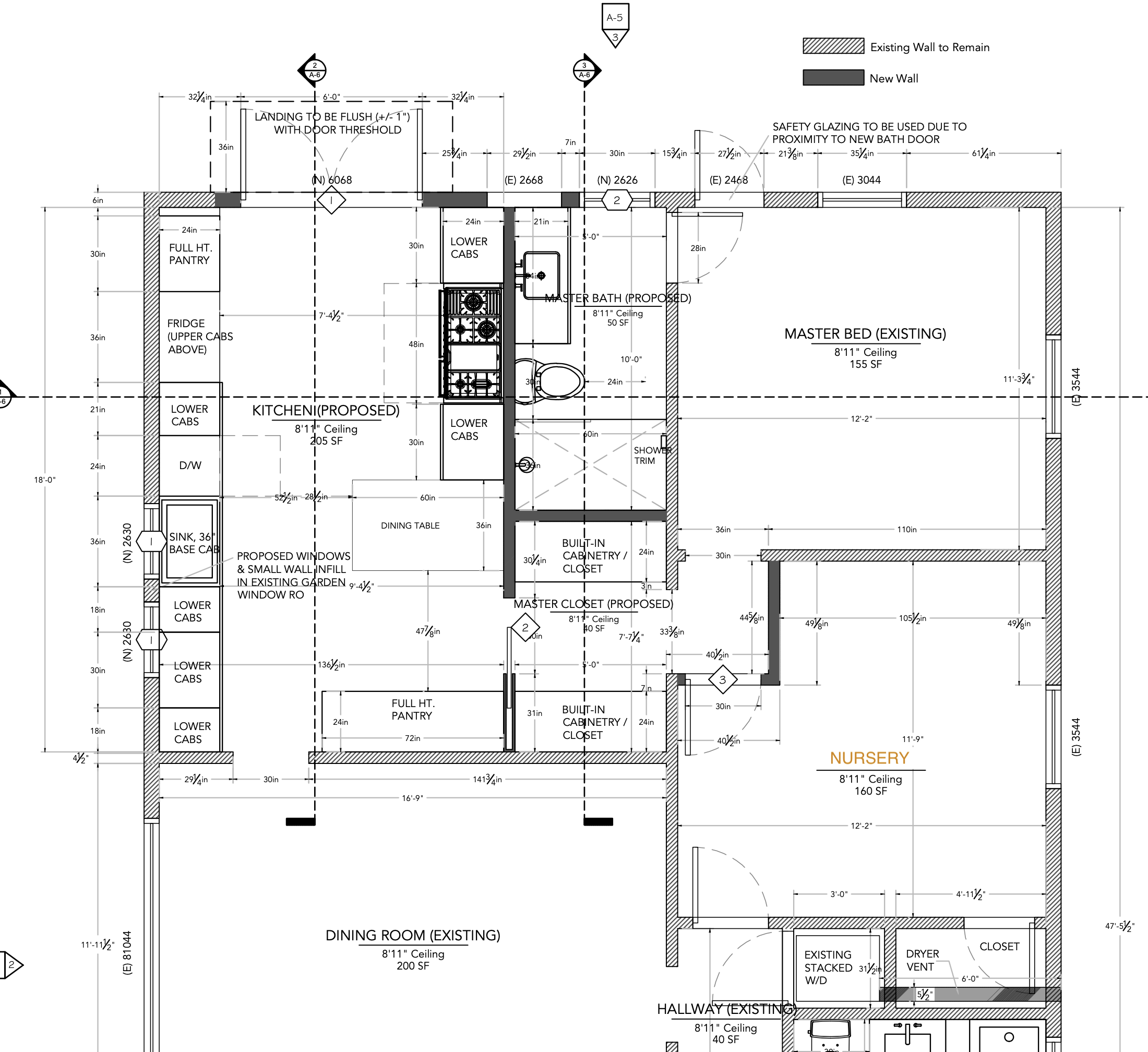
Tue Mar 19 - Written by: Ruth
Small Nursery Layout Ideas; Creating a Functional and Beautiful Space
Explore smart small nursery layout ideas that optimize space while creating a comfortable and organized environment for your baby. Learn how to arrange furniture and storage for maximum efficiency.
A small nursery needs smart planning to work well. You can create a perfect space for your baby by making the most of every inch. This guide will help you turn your small room into a cozy, working nursery that meets all your needs.
Parents often think they need a big room for a nursery, but that’s not true. Small spaces can work just as well with good planning and the right setup.
These ideas will help you create a nursery that is both pretty and useful.
1. Assessing the Space
Start by getting exact measurements of your room. Write down the width and length of each wall. Make note of where doors swing open and how far windows stick out when open. Look for things like air vents, electrical outlets, and light switches that might affect where you put furniture. These details will help you avoid problems later when setting up the nursery.
 Detailed nursery floor plan showing measurements and furniture placement. Source: The Gold Hive
Detailed nursery floor plan showing measurements and furniture placement. Source: The Gold Hive
Take pictures of the room from each corner. This will help you spot things you might miss, like uneven walls or sloped ceilings. Knowing about these features early helps you pick furniture that fits well and looks good in the space.
2. Prioritizing Nursery Essentials
Your baby needs four main things in the nursery: a safe place to sleep, a spot for diaper changes, storage for clothes and supplies, and a place for you to sit. Start with a standard-size crib – it will last longer than a mini crib. Pick a changing table that matches the height of your waist to prevent back strain.
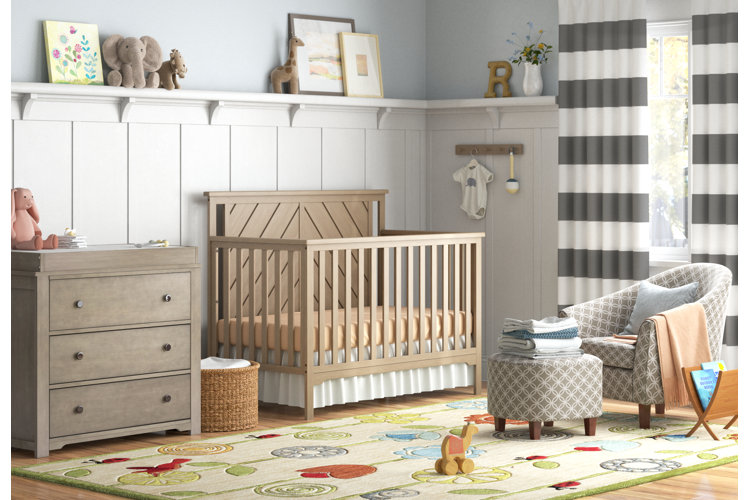 Small nursery layout with essential furniture: crib, changing table and nursing chair efficiently arranged. Source: Wayfair
Small nursery layout with essential furniture: crib, changing table and nursing chair efficiently arranged. Source: Wayfair
Get a comfy chair that fits your body well. You’ll spend many hours sitting in it. Add storage boxes that slide under the crib or fit in corners. This keeps everything you need close by without taking up extra space.
3. Optimizing Furniture Placement
Put the crib on the longest wall, away from windows and heating vents. This spot should be the first thing you see when you walk in. Leave at least two feet of space around the crib for easy access. Place the changing table next to the crib so you can keep one hand on your baby while grabbing supplies.
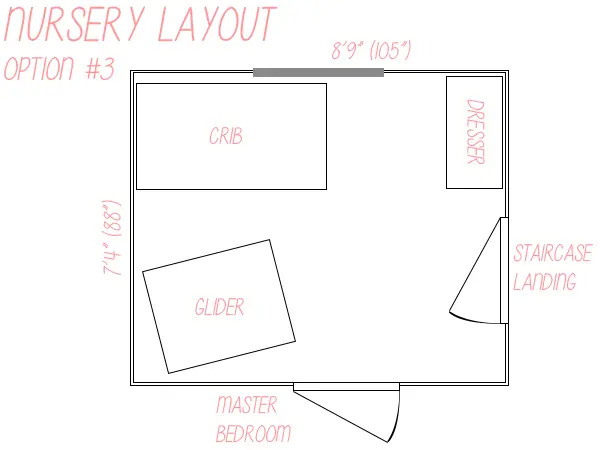 Smart furniture arrangement in a compact nursery maximizing functional space. Source: Angie’s Roost
Smart furniture arrangement in a compact nursery maximizing functional space. Source: Angie’s Roost
Make sure you can walk easily between all pieces of furniture. You need clear paths for those middle-of-night trips to the crib. Test the layout by walking through the room with your arms out, as if carrying a baby and diaper bag.
4. Utilizing Vertical Space
The walls offer lots of storage space that doesn’t take up floor room. Put up sturdy shelves above the changing table for diapers, wipes, and creams. Add more shelves near the crib for books and small toys. Make sure all shelves are mounted securely to wall studs.
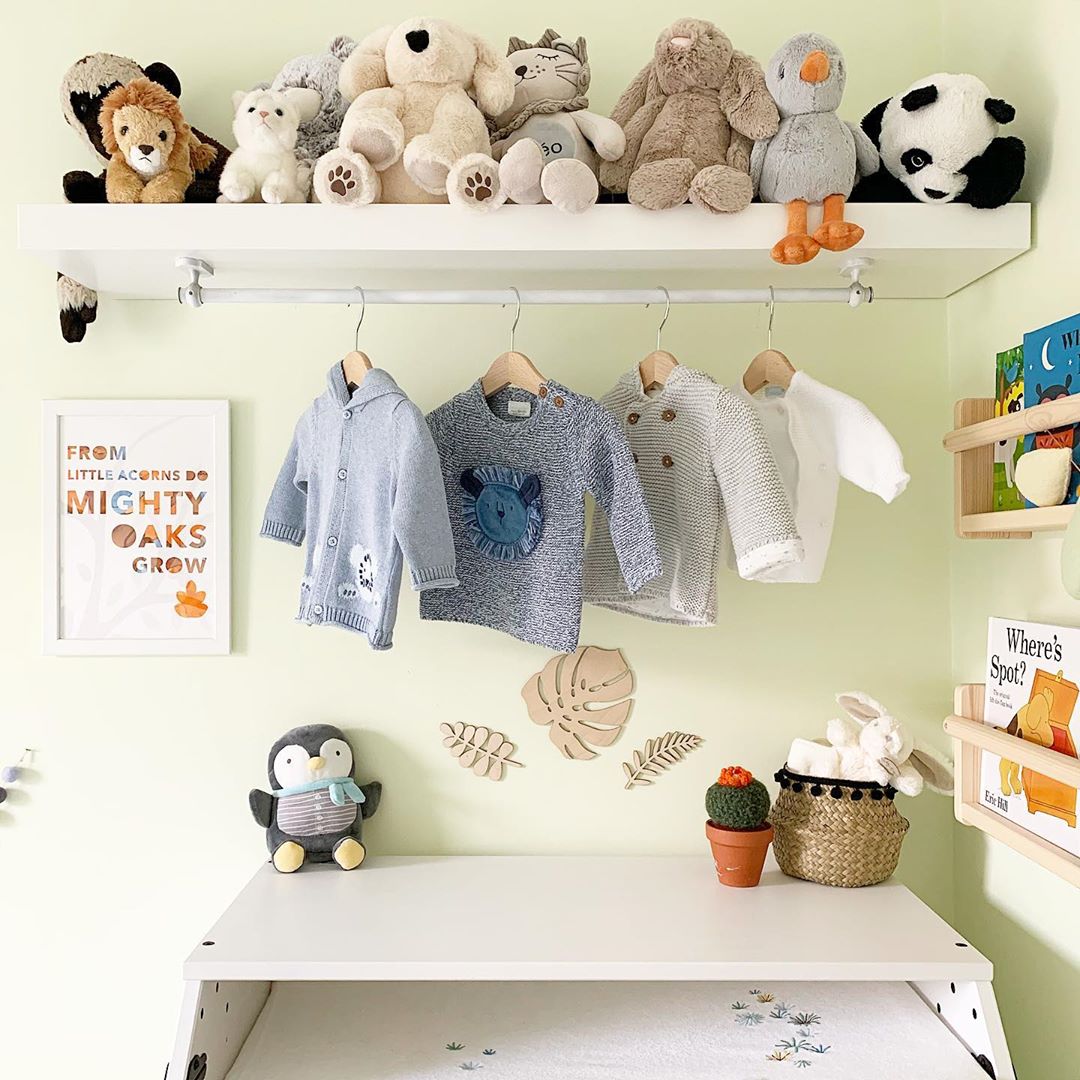 Floating shelves provide vertical storage without taking up valuable floor space in a small nursery. Source: Extra Space Storage
Floating shelves provide vertical storage without taking up valuable floor space in a small nursery. Source: Extra Space Storage
Hang mesh pockets or cloth organizers on the walls or back of the door. These hold small items like socks, bibs, and pacifiers. Keep heavier items on lower shelves and lighter things up high. This makes the room safer and more organized.
5. Incorporating Multi-Functional Furniture
Pick furniture that serves more than one purpose. A dresser with a changing pad on top works as both storage and changing station. Look for a crib with built-in drawers underneath. This gives you storage space without needing extra furniture.
 Crib with built-in storage drawers underneath, maximizing space in a small nursery. Source: WoowBaby
Crib with built-in storage drawers underneath, maximizing space in a small nursery. Source: WoowBaby
Consider a small desk that can work as a changing table now and later become a homework spot. Get storage ottomans that work as seats and toy boxes. This type of furniture helps your nursery grow with your child.
6. Creating a Cozy Nursing Nook
Set up a quiet corner for feeding time. Pick a chair that supports your back and arms well. The chair should be small but comfortable enough for long feeding sessions. Place it near a window for natural light during day feeds.
 A well-designed nursing corner with comfortable chair, side table, and good lighting by a window. Source: Tandra Nicole
A well-designed nursing corner with comfortable chair, side table, and good lighting by a window. Source: Tandra Nicole
Add a small side table or wall-mounted shelf next to the chair. This holds water bottles, burp cloths, and your phone. Good lighting is key – install a small reading lamp that you can turn on without getting up.
7. Maximizing Closet Space
Turn the closet into a storage powerhouse. Install a second closet rod to double your hanging space. The top rod holds clothes for future sizes, while the bottom keeps current clothes easy to reach. Use the closet door for more storage by adding an over-door organizer.
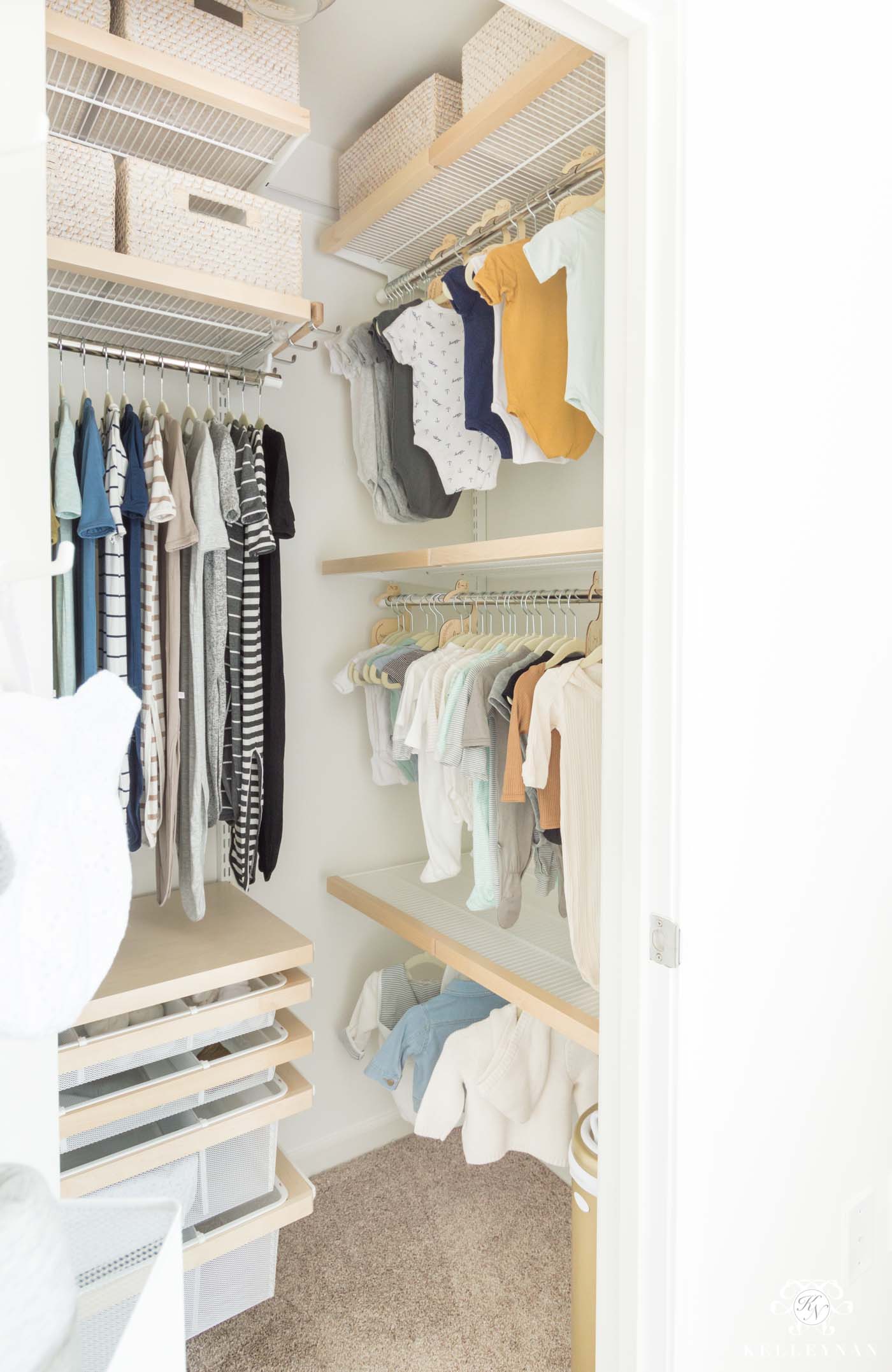 Triple-hang closet system with multiple rods maximizes vertical storage space for baby clothes. Source: Kelley Nan
Triple-hang closet system with multiple rods maximizes vertical storage space for baby clothes. Source: Kelley Nan
Sort baby clothes by size using drawer dividers or small bins. Label everything clearly. Keep daily-use items at eye level and store seasonal or larger sizes up high. This system grows with your baby and keeps clothes organized.
8. Choosing a Light Color Palette
Paint the walls in light colors to make the room feel bigger. White, soft gray, or pale yellow work well as base colors. These colors reflect light and make the space feel open and clean. You can add color through items that are easy to change, like curtains or wall art.
:max_bytes(150000):strip_icc()/stephaniehoeynursery2-5f259645069f435980231ba2a344e603.jpeg) Soft, light color palette makes this small nursery feel open and airy. Source: The Spruce
Soft, light color palette makes this small nursery feel open and airy. Source: The Spruce
Stay away from dark colors that make the room feel smaller. If you want to add darker colors, use them in small amounts on things like picture frames or throw pillows. This keeps the room feeling open while still having personality.
9. Enhancing Lighting
Good lighting helps you see well during nighttime baby care. Install a ceiling light with a dimmer switch. This lets you adjust the brightness for different tasks. Put a nightlight near the changing table and crib for midnight diaper changes.
 Soft, dimmable nursery lamp provides gentle lighting for nighttime baby care. Source: Amazon
Soft, dimmable nursery lamp provides gentle lighting for nighttime baby care. Source: Amazon


Add a small lamp with a soft bulb near your nursing chair. The light should be bright enough to help you see but gentle enough not to fully wake the baby. Make sure all lights can be turned on and off without making noise.
10. Personalizing the Space
Add special touches that make the nursery feel warm and loved. Hang one or two meaningful pieces of art where you and your baby can see them. Put up family photos or a special mobile above the crib. Keep decorations simple to avoid making the small space feel crowded.
 Simple, personalized wall art adds character to a nursery without overwhelming the space. Source: Etsy
Simple, personalized wall art adds character to a nursery without overwhelming the space. Source: Etsy

Pick a soft rug that adds comfort and style. Make sure it’s easy to clean and won’t slip. Add a few stuffed animals or special blankets, but don’t overdo it. A few well-chosen items mean more than lots of decorations.